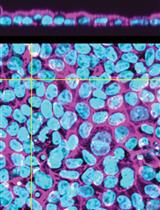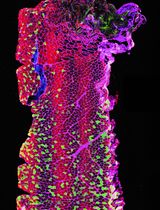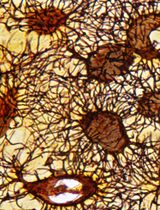- EN - English
- CN - 中文
A Method for Culturing Mouse Whisker Follicles to Study Circadian Rhythms ex vivo
一种离体研究昼夜节律的小鼠触须毛囊培养方法
发布: 2019年01月20日第9卷第2期 DOI: 10.21769/BioProtoc.3148 浏览次数: 5495
评审: Alessandro DidonnaWilliam C. W. ChenYunbing Ma

相关实验方案

自动层次分析(ALAn):用于无偏见表征培养中哺乳动物上皮结构的图像分析工具
Christian Cammarota [...] Tara M. Finegan
2024年04月20日 3591 阅读
Abstract
Ex vivo tissue-culture experiments are often performed in the field of circadian biology. The major aim of these experiments is to evaluate circadian characteristics such as period length at the tissue-autonomous level by monitoring clock gene expression in real time. This culture method is also used to examine the tissue specificity of circadian entrainment factors. However, an ex vivo culture method for monitoring clock gene expression in hair follicles has yet to be established. In the present study, we developed an experimental method to analogize and evaluate circadian characteristics by performing ex vivo culture of mouse whisker follicles and monitoring clock gene expression in real time.
Keywords: Circadian rhythm (昼夜节律)Background
Almost all living organisms exhibit physiological and behavioral circadian rhythms that are driven by the circadian clock (Takahashi, 2017). The circadian clock enables maximum expression of genes at appropriate times of the day, allowing organisms to appropriately adapt to environmental rhythms generated by the Earth’s rotation. The clockwork consists of ubiquitous, cell-autonomous and clock gene-driven negative feedback loops of transcription (Schibler et al., 2015). In mammals, the transcription factors BMAL1 and CLOCK activate the transcription of clock and clock-related genes such as Period (Per) and Cryptochrome (Cry) via E-box elements. PER, together with CRY, a potent transcriptional inhibitor, subsequently function to negatively regulate this complex (Kume et al., 1999).
Ex vivo tissue-culture experiments are often performed in the field of circadian biology (Yamazaki et al., 2000). The major aim of these experiments is to evaluate the circadian characteristics of clock gene expression such as period length at the tissue-autonomous level and to compare these characteristics with those at the whole-body level (Liu et al., 2007). For example, the effect of the dysfunction of a clock gene in question can be investigated by comparing the effects in ex vivo tissue culture and behavior and physiology. This culture method is also used to examine the tissue specificity of circadian entrainment factors (Sato et al., 2014). Specifically, this technique can be used to reveal in which tissue a humoral factor in question modulates circadian phase or amplitude. Additionally, although controversial, some studies suggest that the circadian phase observed in ex vivo cultured tissues can be used to estimate that in vivo (Stokkan et al., 2001).
In the present study, we developed an experimental method to analogize and evaluate circadian characteristics based on ex vivo culture of mouse whisker follicles. Briefly, individual whisker follicles are carefully dissected from mice carrying a luciferase gene whose expression is driven by a circadian promoter, and bioluminescence is measured in real time using a photomultiplier tube. This method can be useful for a wide range of applications as mentioned above.
Materials and Reagents
- 100 mm Petri dish (IWAKI, catalog number: SH90-20)
- 35 mm culture dish (IWAKI, catalog number: 1000-035)
- Eppendorf tube
- Inbred mice such as male 5-20-week-old C57/BL6 mice carrying the luciferase gene driven by a clock gene promoter (in our original paper, we used Per2::luc knock-in mice and Bmal1-Eluc transgenic mice, which were gifts from Dr. Joseph Takahashi and Dr. Yoshihiro Nakajima, respectively) (Yoo et al., 2004; Noguchi et al., 2012a)
- Silicone (Shin-Etsu, catalog number: KS-64)
- 70% ethanol (Shinwa Alcohol Industry, catalog number: 4079210060)
- Phosphate-buffered saline (PBS) (Nacalai Tesque, catalog number: 14249-24)
- DMEM (Nacalai, catalog number: 08456-94)
- Penicillin/streptomycin (Thermo Fisher Scientific, GibcoTM, catalog number: 15070-063)
- Dexamethasone (Sigma-Aldrich, catalog number: D4902)
- Luciferin (WAKO, catalog number: 126-05116)
- Dimethyl sulfoxide
- DMEM supplemented with penicillin/streptomycin (see Recipes)
- Luciferin-containing medium (see Recipes)
- 1,000x DEX stock (see Recipes)
Equipment
- Surgical scissors (Hammacher, catalog number: 91-1538)
- Claw tweezers (FST, catalog number: 11154-10)
- Fine tweezers (FST, catalog number: 18132-12)
- Laminar flow cabinet (SANYO, model: MCV-B131F)
- CO2 incubator with an infrared sensor that is not affected by humidity inside the chamber (ASTEC, model: SCA-165DRS)
- Photomultiplier tube (Hamamatsu, model: LM2400)
- Dissecting microscope (Nikon, model: SMZ745T)
Software
- Software for Photon Detection Unit C10749(LM2400v21)-JP
- Cosinor software
Procedure
文章信息
版权信息
© 2019 The Authors; exclusive licensee Bio-protocol LLC.
如何引用
Nishida, A., Miyawaki, Y., Node, K. and Akashi, M. (2019). A Method for Culturing Mouse Whisker Follicles to Study Circadian Rhythms ex vivo. Bio-protocol 9(2): e3148. DOI: 10.21769/BioProtoc.3148.
分类
细胞生物学 > 组织分析 > 组织成像
您对这篇实验方法有问题吗?
在此处发布您的问题,我们将邀请本文作者来回答。同时,我们会将您的问题发布到Bio-protocol Exchange,以便寻求社区成员的帮助。
提问指南
+ 问题描述
写下详细的问题描述,包括所有有助于他人回答您问题的信息(例如实验过程、条件和相关图像等)。
Share
Bluesky
X
Copy link










